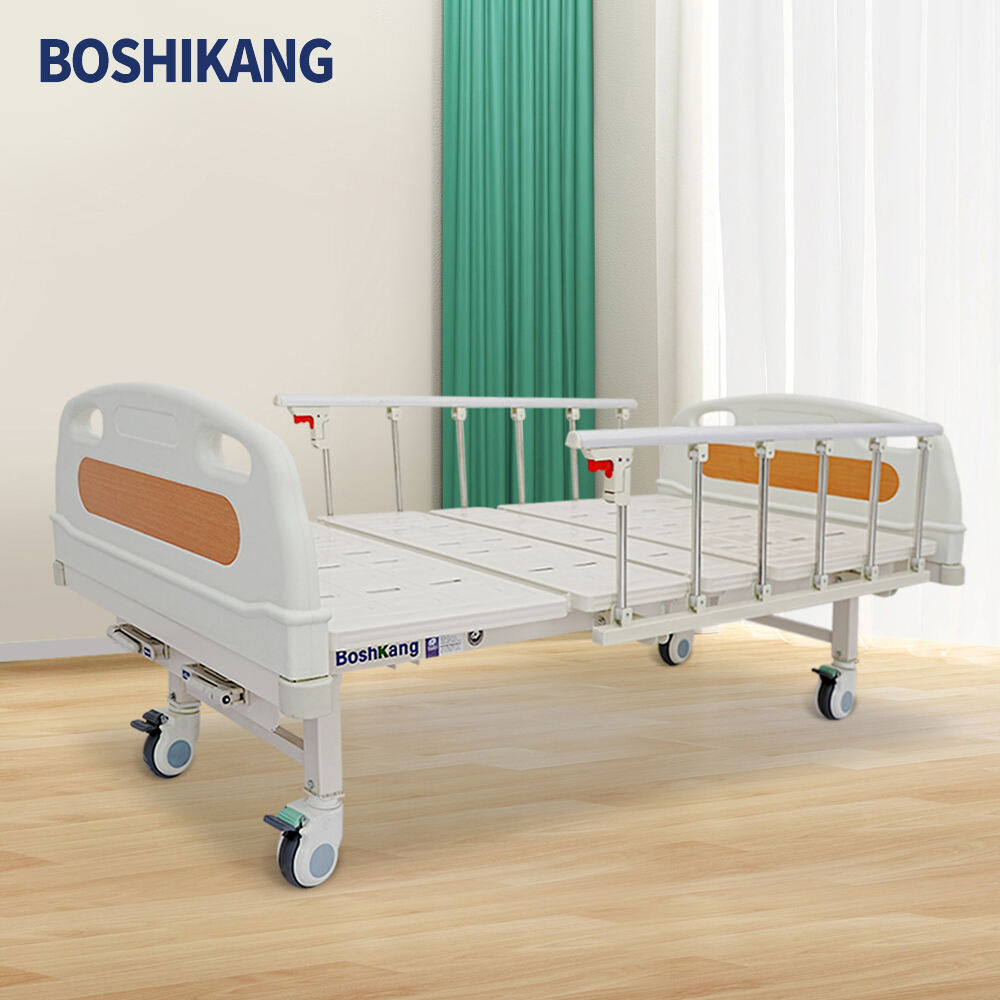The Importance of Choosing the Right Electric Medical Bed
Impact on Patient Comfort and Recovery Outcomes
Choosing an appropriate electric medical bed makes a real difference in how comfortable patients feel during their stay and can actually speed up recovery time. Modern beds come equipped with various features that help patients get into better resting positions something that plays a big role in the healing process. Research from the Journal of Advanced Nursing shows that when patients have access to beds with different positioning settings, they tend to report feeling more comfortable overall and recover faster too. The adjustable parts at the head and feet area are particularly useful because they help prevent those painful pressure sores that often bother people who spend long periods lying down. Allowing patients to tweak their bed position as needed not only improves their physical condition but also boosts morale during what can be a challenging time.
Role in Caregiver Efficiency and Safety
Electric medical beds help both patients and make life easier for caregivers too. These beds automate many tasks that would otherwise require lots of physical work from staff, cutting down on the backaches and strains they often get when moving or adjusting patients. Healthcare facilities report that their staff members suffer fewer injuries and feel less tired after switching to electric models. The beds come with buttons and controls that let caregivers change positions quickly without struggling manually. This means nurses spend less time wrestling with equipment and more time actually caring for patients. Hospitals across the country have seen improvements in how fast treatments happen and overall satisfaction levels among both workers and residents since adopting these modern bed systems.
Understanding Semi-Electric Medical Beds: Features and Benefits
Manual height adjustment with electric head/foot controls
Semi electric medical beds combine both manual and electronic features in a way that works well for most situations. The beds let staff adjust height manually but have electric controls specifically for raising and lowering the head and foot parts. Caregivers can change the bed level by hand when needed, then switch to electric adjustments for those head and foot positions that really matter for patient comfort. This kind of flexibility means patients get better rest positions without putting too much strain on the people taking care of them. That's especially important in hospitals where patients come with all sorts of different needs. Even though there's still some manual work involved, these semi electric models are much easier to handle than completely manual beds. They save money over time while still giving access to those key electric functions that make a big difference in daily care routines.
Ideal scenarios for semi-electric bed usage
Semi electric beds really shine in certain situations like after surgery recovery or when someone needs care at home. They balance flexibility with reasonable costs, which matters a lot in these contexts. These beds work great for temporary arrangements whether it's someone recovering at home or in a short term clinic setting. Take post op patients for example. The fact that nurses can adjust both head and foot sections electronically makes all the difference. Patients just feel better and tend to heal faster when they're comfortable. Another thing worth mentioning is how adaptable these beds actually are across different types of care environments. Many hospitals and clinics have found that semi electric models handle everything from basic rest to more complex positioning needs without breaking the bank. That versatility solves real world problems every day in medical facilities around the globe.
Cost-effectiveness for temporary care situations
When looking at money matters, semi electric beds actually work pretty well compared to the fully electric versions when someone needs temporary care. These beds strike a good middle ground between what's needed functionally and what people can afford. Facilities or individual caregivers often find they save quite a bit by going this route instead of spending top dollar on those fancy all electric models. For instance, a semi electric model might cost around half price but still provide most of the essential features without breaking the bank. And here's another thing worth mentioning - sometimes insurance companies or even Medicare will pay for these beds if a doctor says they're medically necessary. That really takes some pressure off financially and gives folks real options whether they want to rent or buy outright depending on their situation.

Exploring Fully Electric Medical Beds: Capabilities and Advantages
Complete Electrical Adjustability of All Bed Positions
Electric hospital beds give users total control over how they position themselves in bed, which helps everyone from patients to nurses. The ability to fine tune positions means better comfort all around. Studies point to something pretty important here too - when we get bed positioning right for those at higher risk, it makes a real difference in their recovery. Pressure sores go down and blood flow gets better overall. In hospitals and care facilities, this kind of flexibility matters a lot because getting someone positioned correctly can literally save lives sometimes. What's really nice about these modern beds is the automation aspect. People who struggle with movement can still change positions on their own without needing help every time. That means less work for staff and more freedom for patients who want to manage their own comfort levels during treatment.
Enhanced Accessibility Features for Immobile Patients
Electric beds built for people who can't move around much come loaded with features that really help improve access and general care levels. Most models these days offer things like raising the head or adjusting the angle, making it much easier to transfer patients between surfaces while also cutting down on pain points. Some newer versions even have smart tech built in now, with sensors that detect when someone shifts position and then automatically adjust settings accordingly. This kind of innovation shows just how far medical equipment has come lately. Better bed design means better outcomes for everyone involved, especially those needing long term support without constant assistance from caregivers.
Long-term Care Applications and Chronic Condition Management
Electric beds work really well in long term care places and when managing chronic illnesses. These beds can adjust constantly to give proper support where needed most for folks dealing with ongoing health issues day after day. Studies show that patients tend to have better results overall when using these types of beds because caregivers can keep track of their condition continuously and make changes as necessary throughout treatment periods. In hospitals and nursing homes across the country, staff members rely heavily on electric beds to maintain comfort levels while following complex treatment regimens that often last weeks or even months at a time. The ability to fine tune positioning makes all the difference for both recovery rates and quality of life during extended stays.
Key Differences
Adjustability & Control – Manual vs. Full Automation
Looking at how adjustable these two types of beds really are shows some pretty big differences when it comes to control and overall comfort. Semi electric models typically let people adjust the head and foot parts with electricity, but they still need to manually crank the whole bed up or down. Fully electric versions take things further by giving automatic control over every single position. This means patients can get into just the right spot without struggling, which definitely matters for those who need precise positioning. Many folks who have used them say the fully electric beds make life so much easier when trying to find comfortable sleeping positions that actually help their health problems. Research backs this up too, showing that being able to adjust posture properly leads to better results especially for patients at higher risk.
Ease of Use for Caregivers – Impact on Workload and Efficiency
What caregivers actually say shows how different the work feels when using semi electric versus full electric hospital beds. The fully electric models make life easier because everything adjusts automatically, so nurses don't have to lift or push as much, which means they can get things done faster while keeping patients safer too. Some research out there points to these automatic features cutting down mistakes and making daily routines quicker, giving medical staff more time to talk with patients instead of wrestling with bed controls all day long. Learning to operate the fully electric versions usually takes less time since most people find them intuitive to use. Semi electric beds require extra instruction just to handle those manual height changes properly, something that adds to the overall learning curve for new staff members.
Cost Considerations – Price Comparison and Value for Money
Looking at the numbers shows semi electric hospital beds typically come in cheaper than their fully electric counterparts. Prices for semi models usually fall somewhere between $1k and $3k while full electric versions range from about $2k up to around $5k. Facilities working within tight budgets often find semi electric beds make sense when factoring in all costs over time, especially considering maintenance expenses and warranty coverage. But many medical institutions report better value in the long run with fully electric beds despite higher upfront costs. These facilities point to lower repair bills and extra features that boost patient comfort and staff efficiency. Several nursing homes actually made the switch to full electric beds recently, mainly because they saw money saved on repairs plus noticed patients were happier overall with the added adjustments these beds offer.
Best Use Cases – When to Choose Semi-Electric vs. Fully Electric Beds
The choice between semi electric and full electric hospital beds really comes down to what works best for each situation and individual patient requirements. For folks who need only basic positioning changes but want something budget friendly, semi electric models make sense. These often show up in places like short term rehab centers or at homes where money matters most. On the flip side, hospitals and nursing homes typically go for full electric versions because they can adjust so many different ways quickly. We're seeing more healthcare providers opt for these advanced models lately too, especially since there's growing emphasis on creating better patient experiences through technology integration across medical facilities nationwide.
FAQ
What is the main benefit of fully electric beds?
Fully electric beds provide comprehensive control over all bed positions, making it easier for both patients and caregivers to ensure optimal comfort and precise adjustments.
Why might some facilities choose semi-electric beds?
Semi-electric beds are often chosen for their cost-effectiveness, providing essential adjustability features while remaining affordable.
How do electric medical beds enhance care for immobile patients?
Electric medical beds offer automated adjustments like elevation and tilt, which aid in patient transfers and minimize discomfort, particularly benefiting immobile patients.
Are funding options available for purchasing electric medical beds?
Yes, many funding options, including insurance or Medicare, may cover electric medical beds if deemed medically necessary.


